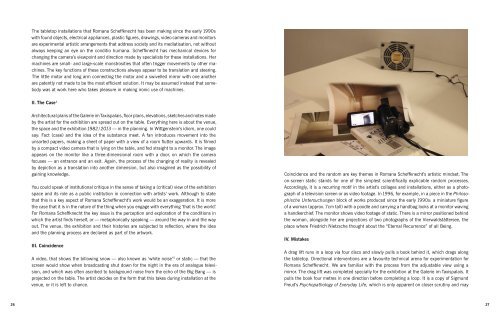ROMANA SCHEFFKNECHT 1982 2013 - romana scheffknecht videos
ROMANA SCHEFFKNECHT 1982 2013 - romana scheffknecht videos
ROMANA SCHEFFKNECHT 1982 2013 - romana scheffknecht videos
Sie wollen auch ein ePaper? Erhöhen Sie die Reichweite Ihrer Titel.
YUMPU macht aus Druck-PDFs automatisch weboptimierte ePaper, die Google liebt.
The tabletop installations that Romana Scheffknecht has been making since the early 1990s<br />
with found objects, electrical appliances, plastic figures, drawings, video cameras and monitors<br />
are experimental artistic arrangements that address society and its mediatisation, not without<br />
always keeping an eye on the conditio humana. Scheffknecht has mechanical devices for<br />
changing the camera’s viewpoint and direction made by specialists for these installations. Her<br />
machines are small- and large-scale monstrosities that often trigger movements by other machines.<br />
The key functions of these constructions always appear to be translation and steering.<br />
The little motor and long arm connecting the motor and a swivelled mirror with one another<br />
are patently not made to be the most efficient solution. It may be assumed instead that somebody<br />
was at work here who takes pleasure in making ironic use of machines.<br />
II. The case 4<br />
Architectural plans of the Galerie im Taxispalais, floor plans, elevations, sketches and notes made<br />
by the artist for the exhibition are spread out on the table. Everything here is about the venue,<br />
the space and the exhibition <strong>1982</strong> / <strong>2013</strong> — in the planning. In Wittgenstein’s idiom, one could<br />
say: Fact (case) and the idea of the substance meet. A fan introduces movement into the<br />
unsorted papers, making a sheet of paper with a view of a room flutter upwards. It is filmed<br />
by a compact video camera that is lying on the table, and fed straight to a monitor. The image<br />
appears on the monitor like a three-dimensional room with a door, on which the camera<br />
focuses — an entrance and an exit. Again, the process of the changing of reality is revealed<br />
by depiction as a translation into another dimension, but also imagined as the possibility of<br />
gaining knowledge.<br />
You could speak of institutional critique in the sense of taking a (critical) view of the exhibition<br />
space and its role as a public institution in connection with artists’ work. Although to state<br />
that this is a key aspect of Romana Scheffknecht’s work would be an exaggeration. It is more<br />
the case that it is in the nature of the thing when you engage with everything ‘that is the world’.<br />
For Romana Scheffknecht the key issue is the perception and exploration of the conditions in<br />
which the artist finds herself, or — metaphorically speaking — around the way in and the way<br />
out. The venue, the exhibition and their histories are subjected to reflection, where the idea<br />
and the planning process are declared as part of the artwork.<br />
III. coincidence<br />
A video, that shows the billowing snow — also known as ‘white noise’ 5 or static — that the<br />
screen would show when broadcasting shut down for the night in the era of analogue television,<br />
and which was often ascribed to background noise from the echo of the Big Bang — is<br />
projected on the table. The artist decides on the form that this takes during installation at the<br />
venue, or it is left to chance.<br />
Coincidence and the random are key themes in Romana Scheffknecht’s artistic mindset. The<br />
on-screen static stands for one of the simplest scientifically explicable random processes.<br />
Accordingly, it is a recurring motif in the artist’s collages and installations, either as a photograph<br />
of a television screen or as video footage. In 1996, for example, in a piece in the Philoso-<br />
phische Untersuchungen block of works produced since the early 1990s: a miniature figure<br />
of a woman (approx. 7cm tall) with a poodle and carrying a handbag looks at a monitor waving<br />
a handkerchief. The monitor shows video footage of static. There is a mirror positioned behind<br />
the woman, alongside her are projections of two photographs of the Vierwaldstättersee, the<br />
place where Friedrich Nietzsche thought about the “Eternal Recurrence” of all Being.<br />
IV. Mistakes<br />
A drag lift runs in a loop via four discs and slowly pulls a book behind it, which drags along<br />
the tabletop. Directional interventions are a favourite technical arena for experimentation for<br />
Romana Scheffknecht. We are familiar with the process from the adjustable view using a<br />
mirror. The drag lift was completed specially for the exhibition at the Galerie im Taxispalais. It<br />
pulls the book four metres in one direction before completing a loop. It is a copy of Sigmund<br />
Freud’s Psychopathology of Everyday Life, which is only apparent on closer scrutiny and may<br />
26 27


